#saint thomas becket
Text
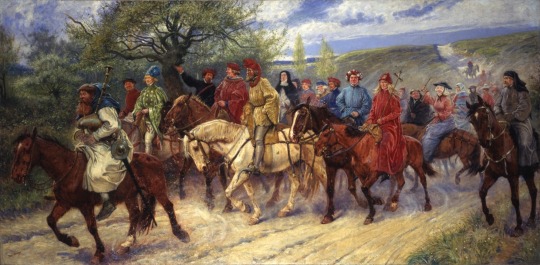
The Canterbury Pilgrims by Paul Hardy
#the canterbury tales#art#illustration#paul hardy#canterbury#pilgrims#england#medieval#middle ages#english#geoffrey chaucer#chaucer#history#canterbury tales#tales of caunterbury#st thomas becket#saint thomas becket#kingdom of england
395 notes
·
View notes
Text
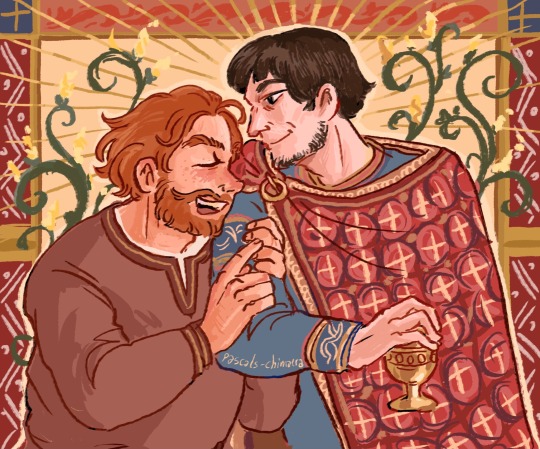
I'd be appalled if I saw you ever try to be a saint / Couldn't fall for someone I thought couldn't misbehave / I want you to know that I've had no love like your love
#Henry ii#thomas becket#Saint Thomas Becket#12th century#medieval#becket or the honor of God#my art#henrybecket#Was listening to wasteland baby and was like. Huh. Hmmm . Hah
13 notes
·
View notes
Text
St Thomas Becket
Today is the feast day of St Thomas Becket of Canterbury, venerated as a saint and martyr by both the Catholic and Anglican Churches. His conflict with Henry II, King of England, over the rights and privileges of the Church led to his murder by followers of the king in Canterbury Cathedral. T.S. Eliot's play Murder in the Cathedral, tells his story.
10 facts about him:
0 notes
Text
I walked across the apartment on my knees for comedic effect but it has guaranteed that I will never frustratedly ask what to do with a disobedient archbishop to my eager knights.
0 notes
Photo
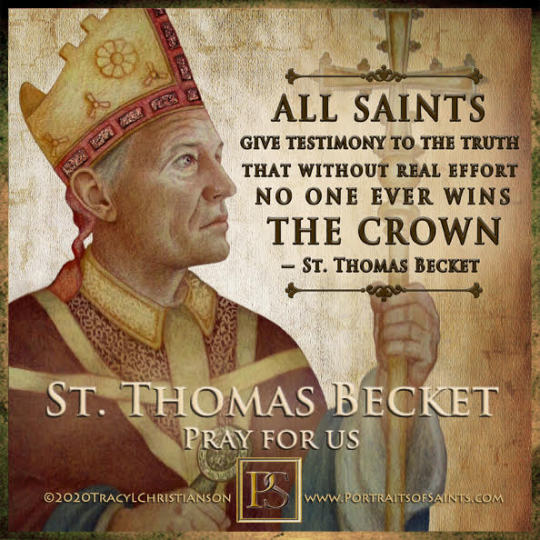
Saint Thomas Becket
1118 - 1170
Feast day: December 29
Patronage: secular clergy; Portsmouth, England; Exeter College, Oxford, England
Thomas Becket, also known as Saint Thomas of Canterbury, was Archbishop of Canterbury, from 1162 until his murder in 1170. He is venerated as a saint and martyr by both the Catholic Church and the Anglican Communion. He engaged in conflict with Henry II of England over the rights and privileges of the Church and was murdered by followers of the king who split his skull with their swords as he knelt before the altar at Canterbury Cathedral.
{website}
60 notes
·
View notes
Text
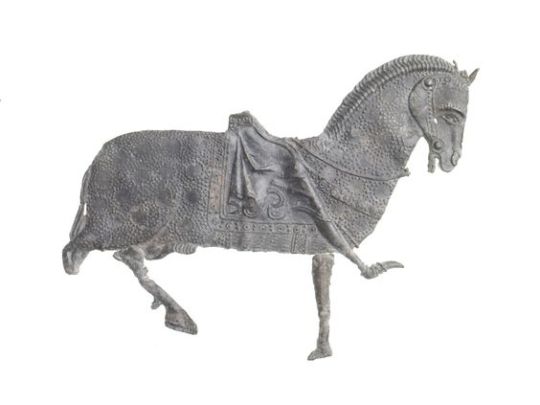
Part of a pilgrim badge from the shrine of St Thomas Becket at Canterbury Cathedral. This badge depicts part of the scene of Thomas Becket returning from exile in France and refers to his journey from Sandwich to Canterbury on horseback. All that remains of this badge is Becket’s dappled horse and the lower part of Becket’s body. Becket’s cloak hangs in folds across the saddle and his right leg is stretched out straight ahead. He wears pointed shoes.
Thomas Becket was born in London in 1118. He became a royal official and a great friend of King Henry II. He was made Archbishop of Canterbury in 1162. He argued with King Henry II, and fled to France in 1164. Thomas Becket returned to Canterbury in 1170 and was killed in the cathedral by four knights who thought this would please the king. People were outraged at the murder of an archbishop on holy ground and Becket was made a saint. He became one of the patron saints of London. Many Londoners travelled to Canterbury to pray at the shrine there and bought badges and ampullae (small bottles for holy water) as souvenirs of their pilgrimage.
Late Medieval; late 14th century
#St Thomas Becket#Late Medieval#late 14th century#pilgrim badge#patron saints of London#patron saint#museum of london
18 notes
·
View notes
Note
Vote for St. Thomas a Beckett! Anyone who could still piss off Oliver Cromwell 350 years after his death at least deserves a chance!
YASS YESS YISSSS THOMAS BECKET!!!!! send more propaganda for him!!!
another vote recorded :)
12 notes
·
View notes
Text
SAINT OF THE DAY (December 29)

St. Thomas was born around the year 1117 in London, England.
He was the son of pious parents. His mother converted to Christianity through the example and teachings of his father.
From his early youth, Thomas was educated in religion and holiness.
After his childhood, Thomas was taught at a monastery, and later, at a school in London.
After the death of both his parents, Thomas decided to finish his schooling by studying canon law.
He was successful in his studies and was made secretary to one of the courts of London.
After working for a while at law, Thomas decided to dedicate the rest of his life to God and began to work towards ordination.
In all that he did, Thomas diligently applied himself and became well known as a holy and honest worker.
His work came under the scrutiny of his friend, King Henry II.
In 1157, Thomas was asked to serve as Lord Chancellor to the king. After the bishop of Canterbury died, Henry sought to elect Thomas to the position.
In 1162, this suggestion was accepted by a synod. Thomas warned the king that it might cause friction and conflict of interests, but nevertheless accepted the position.
Thomas served as bishop by seeking to help the people and develop his own holiness.
He practiced many penances and was very generous to the poor with both his time and his money.
As Henry's reign continued, he began more and more to exercise his hand in Church affairs.
This caused many disagreements with Thomas, and after one especially trying affair, he retired for a while to France.
When Thomas returned to England, he again became involved in a dispute with the king.
Some of the king's knights saw this as treason, and as a result, they killed Thomas in his own Church.
From St. Thomas, the modern Catholic can find inspiration to be courageous in their steadfastness with what they know to be right and holy.
2 notes
·
View notes
Text

A middle ages Catholic religious image of the martyrdom of St. Thomas Beckett, Archbishop of Canterbury. Murdered by lords of King Henry II of England.
#traditional catholicism#traditional catholic images#traditional catholic middle ages art#middle ages catholism#traditional catholic history#traditional catholic saints#traditional catholic saints images#st. thomas a becket#traditional catholic saint martyrs#archbishop of canterbury#king henry ii of england
24 notes
·
View notes
Text

St. Thomas Becket Ora Pro Nobis
#St. Thomas Becket#St. Thomas Becket Quotes#Saint Quotes#Quotes from the saints#Trad#Tradlr#ora pro nobis#brainyquote#christian persecution#persistence#pope benedict ‘very sick’ & ‘worsening’ while under constant medical care as vatican calls for ‘prayers’#pope benedict#benedict
6 notes
·
View notes
Text
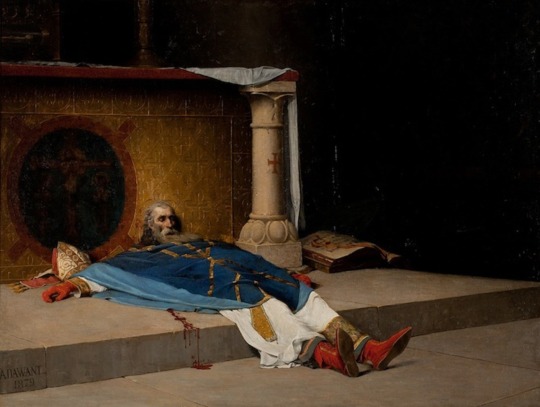


The Murder of St Thomas à Becket by Albert Pierre Dawant
#thomas becket#martyr#saint#martyrdom#murder#canterbury cathedral#archbishop#priest#canterbury#england#english#normandy#art#history#medieval#middle ages#christianity#christian#cathedral#europe#european#henry ii
152 notes
·
View notes
Text


THE DESCRIPTION OF SAINT THOMAS BECKET
Feast Day: December 29
"Wait the end with joy. It is the end which characterizes everything and which tests a man's expectations."
Pictured above is from the 1964 film starring the late Richard Burton.
Born in London in 1118, Thomas was of Norman stock. He was initiated into an ecclesiastical career at a young age. Trained in the abbey of Merton, he later studied in France and at the University of Bologna and soon distinguished himself for his intellectual qualities. In 1154 he became archdeacon of the diocese of Canterbury and the following year, the new king of England, Henry II, appointed him chancellor of the realm. Thomas was the king's most trusted man. He lived a comfortable life, and did not disdain the symbols and privileges of power. However, the future Saint did not fail in generosity towards the poor, and showed an inner freedom even in the face of the sovereign, to whom he was not only a counselor, but also a trusted friend.
The turning point in the life of Thomas Becket took place in 1161 when he accepted election as Archbishop of Canterbury. That appointment was strongly advocated by King Henry, who would never have thought of finding a proud adversary in the man, who was once his closest collaborator. Thomas, however, was from then, on, a servant first of a man far greater than the king of an earthly state. The contrast intensified when Henry II sought to limit the freedom and independence of the Catholic Church in England, through the Clarendon Constitutions.
The king asked Thomas to sign the Charter to limit the prerogatives of the Church, but found an insurmountable bulwark in the new Archbishop of Canterbury. Thomas refused decisively: 'In the name of God Almighty, I will not put my seal.' The old friend thus becomes, in the eyes of the king, a bitter enemy.
Thomas would know the bitterness of exile: after a trial, he fled to France and was first the guest of a Cistercian monastery in Pontigny, for two years. He would spend six years away from his homeland, all told. When he returned to Canterbury he met the joyful reception of the faithful, but an even deeper aversion from the Crown.
It is said that one day Henry II exclaimed in exasperation, words to the effect of, 'Will no one rid me of this turbulent priest!' - an exhortation taken literally by four knights who left London for Canterbury.
Thomas Becket was barbarously killed by stabbing inside his Cathedral. It was December 29, 1170.
It is said that the question of the murderers: 'Where is Thomas the traitor?' was answered with: 'I am here, though I am not a traitor, but a bishop and priest of God.'
The commotion aroused by this killing was immense, reaching far beyond the borders of England, so much so that only three years later, on 21 February 1173, Pope Alexander III recognized his martyrdom, elevating him to the honor of the altars.
Source: Vatican News
#random stuff#catholic#catholic saints#thomas becket#tomas becket#england#secular clergy#exeter college#becket (1964)
0 notes
Text
Traditional feast days within the Twelve Days of Christmas:
December 25: Christmas Day, the Nativity!
December 26: St. Stephen the first martyr
December 27: St. John the Evangelist
December 28: The Holy Innocents, murdered by Herod
December 29: St. Thomas a Becket and David
December 30: The Feast of the Holy Family (traditionally celebrated on the Sunday within the Octave, but on this day if there is no such Sunday)
December 31: St. Sylvester I, pope during the reign of Constantine and the Council of Nicaea
January 1: Octave-Day of the Nativity, traditionally the Feast of the Circumcision (and now of Mary, Mother of God)
January 2: Feast of the Holy Name of Jesus
January 3: Traditionally no particular saint (that I can find)
January 4: Traditionally no particular saint (now St. Elizabeth Ann Seton)
January 5: St. Telesphorus (second-century pope and martyr) and St. Edward the Confessor (King of England 1042-1066)
January 6: Epiphany! Feast of the Coming of the Magi, the Baptism of Our Lord, and the Wedding at Cana
(An eagle-eyed observer may note that there are thirteen days on this list. Opinions differ slightly as to whether the Twelve Days begin on the 26th or end on the 5th, but I don't think it matters terribly.)
(Also I probably missed some feast days.)
162 notes
·
View notes
Note
For the saints ask, maybe the Blacks from the Dance era. Though I feel it would be more of a folk-saint type deal where it can be very controversial. I’ve wanted to do an ASOIAF book of saints as well, so I’ve thought about it quite a bit😄! The only one I could see being a canonized saint would be Jacaerys since he’s still fondly remembered and possibly Baela or Rhaena (though we don’t know much else about them). From the same era I can definitely see Helaena being canonized since she was probably the most beloved of Alicent’s children according to Fire and Blood. While I also picture Addam Velaryon being canonized too! Another more controversial one would probably be Daemon Blackfyre. I could picture him maybe being a folk-saint since he was described as ‘…he was the Warrior himself.’ Bloodraven as well, though due to how the common people viewed him, I’d say as another folk-saint (even more so since he seems much closer to the Old Gods than the Seven). Then finally (just to cut my rant short😅) I’d say Naerys, Aemon the Dargonknight, and Baelor the Blessed for obvious reasons😄. I could also see some saints being more ‘taboo’ in some regions of Westeros than others, even if canonized. I have a lot more but I’m glad I’m not the only one who thinks about possible ASOIAF saints!
i think abt asoiaf saints a lot (i have a bunch of asoiaf/hotd saint posts from a while ago) + am happy other ppl r interested in them too ! saint cults and the canonisation process r part of my degree however i do think we disagree on some of the candidates
under a cut bc this is super long
my main criteria for identifying a potential saint are a) proximity to the seven (in the same way as proximity to life of christ - mostly seven pointed star + pre conquest semi-mythical figures, so hugor and his 44 children or ser galladon) and/or performance of miracles (e.g. baelor and the snakes) b) violent death preferably for the faith in some way (or martyrdom through self-denial or holy self-harm e.g. maegelle dying from the sickness she was tending or baelor’s fasting) c) pious enough for it to be noted in canon if a guy is remembered as ‘the devout’ he’s in d) noted for embodying one of the seven a famous mother a famous maiden a famous warrior e) opponent/victim of some major enemy of the faith because -> f) someone there is a political or economic benefit (especially to oldtown or the faith) to canonising. thomas becket was not spectacularly popular or saintly in life but died violently in a church because of a king the church already didn’t like his impossibly quick three year canonisation (usually took a decade at least) was incredibly politically charged. no candidate has to fit all of these one is enough to go on my maybe list and the more they fit the better
i also have a few things i think broadly exclude from formal canonisation so a) public affiliation with one of the other faiths (old gods rhollor etc) b) affiliation with witches/use of blood magic c) enjoying/having a lot of sex (esp if a woman) and d) this ones kicky and headcanon (but this is all headcanon) but formal brother-sister marriage. the faith never liked targ incest but puts up w it mainly bc of physical dragon intimidation i think they would still be twitchy about canonising incest saints. not saying there’s no targ saints but saying the ones i see for that mainly the ones that actively don’t do the targ incest thing baelor volcel-aemon septa rhaena magaelle. naerys an exception bc it was an established point in medieval virgin saint stories that rape did not count against your virtue + she was obviously a victim of an enemy of the faith famously super pious etc she ticks boxes
imo even though team black were broadly nicer and the kids remembered more fondly if you can give team green anything it’s that they branded themselves as the godly team against the godless team black heathens down to the ground they had that locked. even the green council debates pointedly moralising through a faith lens and esp considering its the firmly greenie oldtown making these calls i think its all easily spun that actually anything bad they ever did was in the name of the seven and trying to maintain andal tradition and keeping the realm out of rhaenyra’s sinful hands etc etc its all bullshit obviously. if the faith is feeling kicky enough to canonise people from the dance its not nice and liked but not especially pious jace its alicent saint of the mother struggling against godless incestuous targ traditions or gwayne hightower with a clear vested hightower interest or criston pious warrior died violently in a religiously charged conflict
baela and rhaena to me both also nice and well remembered they are generally popular political figures they just don’t have much to do with the faith i don’t think anyone’s attributing them theological significance. jace most likely of the strong boys to be a folk saint just bc he did more + still had the violent death but he just isn’t pointedly pious he’s in no way noted for faith which is fairly important even in small local cults. you don’t start to think this guy’s blood might do miracles bc he personally has god’s ear just on a whim
daemon blackfyre superr interesting candidate i think semi-canon folk saint considering we know people were taking pilgrimages to his death site to leave flowers. the fought like the warrior thing is fun bc its often restated clearly part of the narrative + v explicit seven link but maybe not formally canonised as the hightowers backed daeron. would like f&b2 to pass clearer judgement but folk saint daemon blackfyre really good. however do not see saint bloodraven even slightly sorry .. people did not love that guy they were scared of him he was infamously fucking a witch and is arguably the most famous old gods evil wizard westeros ever had. i’d buy saint aemond before saint brynden and aemond is NOT canonised
i think ur completely right abt the faith’s canon saints being controversial and not venerated everywhere - popularity of saints fluctuated based on usefulness of their patronage but also proximity to their major shrine points (usually birthplace or death site) bc being near a pilgrimage site was huge for the local economy, but also notable most medieval saints were from the classical world and so too far in the past to be very controversial. there is certainly a divide in real life between the historical life and the saint life of thomas becket, the standout new medieval saint, and the church could v much tell selectively
45 notes
·
View notes
Text
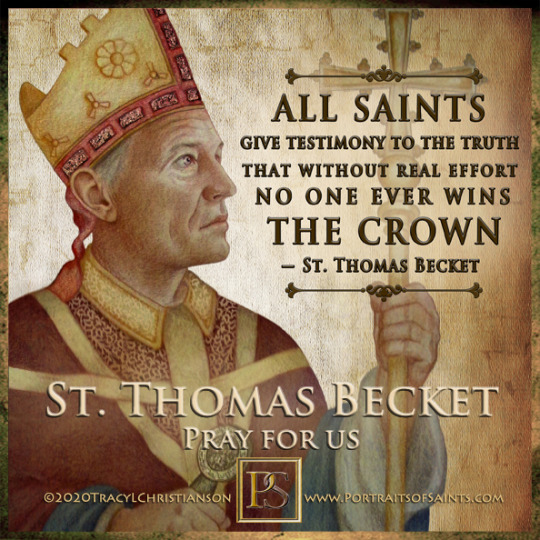
Saint Thomas Becket
1118 - 1170
Feast day: December 29
Patronage: secular clergy; Portsmouth, England; Exeter College, Oxford, England
Thomas Becket, also known as Saint Thomas of Canterbury, was Archbishop of Canterbury, from 1162 until his murder in 1170. He is venerated as a saint and martyr by both the Catholic Church and the Anglican Communion. He engaged in conflict with Henry II of England over the rights and privileges of the Church and was murdered by followers of the king who split his skull with their swords as he knelt before the altar at Canterbury Cathedral.
Prints, plaques & holy cards available for purchase here: (website)
63 notes
·
View notes
Text
fun examples of english saints:
saint george, who never set foot in england in his life
thomas becket, who was deeply unpopular right up until people realised he made a really great martyr, and didn't even martyr himself for his faith so much as for abusing ecclesiastical law
edward the confessor, who couldn't have martyred himself if he'd tried
john fisher, an old man who complained a lot about henry viii then duly got sentenced to death for it, a fate people thought so unfair that henry viii was forced to commute his punishment from hanging, drawing and quartering to a mere beheading
thomas more, not the first thomas to be killed by a king henry over religious issues
20 notes
·
View notes